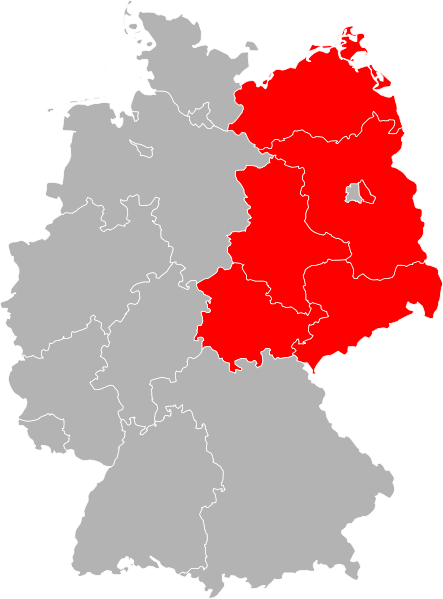By Eric Zuelch

The German Democratic Republic, also known as the GDR, was the eastern portion of Germany that was partially administered by the Soviet Union after the defeat of the Third Reich. Due to the influence of communist Russia, the nation became part of the communist Eastern Bloc countries along with Czechoslovakia, Yugoslavia, and Hungary, among others. East Germany existed from 1949 to 1990. While the East was placed under the influence of communism, West Germany was capitalist under the influence of the French, British, and Americans.
The Soviets formed the Socialist Unity Party out of the German Communist Party and the Socialist Democratic Party, which quickly became the sole ruling party in the East. Soviet military bases were present in the country until reunification. A sizable number of East Germans were originally ethnic Germans who settled in Eastern European countries, but were forced to immigrate to the country due to anti-German sentiment after the war.
After being placed under Russian influence, the remaining factories were taken apart brick by brick and moved to Russia. This greatly hurt the country, as most of Germany’s farmland and industry was in the west. This caused malnourishment and, since there were very little job opportunities, a desire not to work. After hearing that the west was recovering much quicker, many East Germans went west, especially the highly educated and young, hurting the East’s economy more. A five-year plan was implemented to stop migration, but it only caused more strife. Farmers were left with little food for themselves and workers were forced to work longer hours for the same pay, causing more to migrate west. In 1953, a nation-wide protest was held in nearly every city, demanding fair elections. The Soviets were called in and put a stop to it. The border between the two Germanies was fortified, with a wall being enacted through Berlin, a city divided by the allied powers, in 1960. This made migrating west harder. Prior to 1961, over four million defected west, compared to the few thousand who were able afterwards
To keep order, the Ministry for State Security, or Stasi, was formed. The Stasi were a secret police who infiltrated apartment buildings, schools, offices, and hospitals to find those who spoke out against communism. If someone was suspected of being a capitalist, they were arrested and subject to torture. After names of accomplices were given, the accused would be thrown in prison.
Life improved in the 1960s, as jobs and housing were in greater number due to a quarter of the population defecting to the west. By the 1970s it became the wealthiest Eastern Bloc nation. However, most everyday objects were in short supply, causing hoarding. Long lines outside of stores was also common. This was common in all Eastern Bloc countries. During its existence, East Germany had become known its art and media, one of the few ways they could freely express themselves (to an extent). The main focus was to show the superiority of communism over capitalism. Gender equality was also present in the East before the West, encouraging women to partake in the workplace if they so choose.
In the country’s last two decades of existence, East German youths were taking an interest in the culture of the world outside the Eastern Bloc. They did this as a form of silent rebellion against the Socialist Unity Party, as opposed to their parents who viewed the communist state as their savior. In the late 1980s, anti-communist protests erupted again, but the Soviets did not intervene. In November 1989, the Berlin Wall was torn down and the constitution was amended to abolish communism. In 1990, the capitalist west and communist east were reformed into one Germany for the first time since the end of World War One. A portion of Germany was in what is today Poland’s northeastern most territory.
After reunification, the country fell under capitalism, much to the dismay of the communist hardliners. Russian troops returned to the Soviet Union. Factories in the east were shut down, resulting a repeat of the unemployment from the East’s formation. Many Germans in the east, despite growing up in the dictatorship, view it longingly as a form of nostalgia, even seeing themselves as East German rather than German. Other differences can be seen as well, such as the former West Germany being wealthier than the former East. There is also a higher percentage of white supremacists in the eastern part of the country. East Germany was, like other communist countries, a repressive dictatorship that brainwashed its citizens.
Edited by Elliot Gavin Keenan